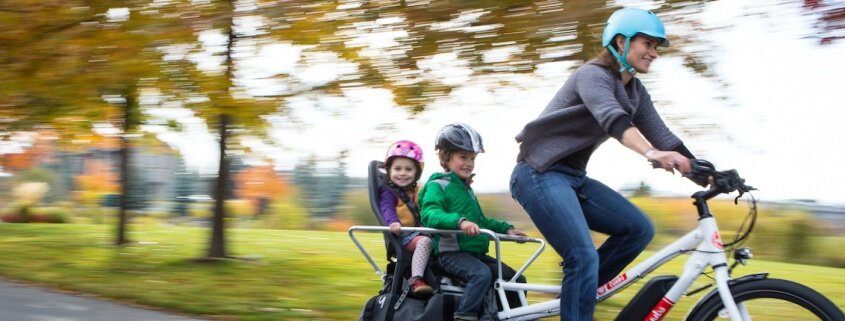E-Bike Bills and Regulations Update
As e-bikes grow more popular, a spate of bills and regulations have cropped up at the state and local levels. CalBike is following several measures in the California legislature that relate to e-bikes. We’re also keeping an eye on new local measures that restrict e-bike use, mostly in Southern California.
Here’s a complete recap of the state legislation we’re watching and a very incomplete accounting of local proposed e-bike restrictions.
CalBike supports: E-bike battery safety
The E-Bike Battery Safety Bill (SB 1271, Min) would require all electric bikes sold in California to meet certain minimum safety standards and be certified by an accredited testing laboratory. We support this bill, which passed in the Senate and was just approved by the Assembly Transportation Committee. The next step is the Assembly Committee on Emergency Management.
Battery safety is critical for e-bikes since people often park their bikes inside homes or garages and bring the batteries inside to charge. Poorly manufactured lithium-ion batteries can overheat during charging and start fires. New York City, where delivery drivers often ride hundreds of miles and rely on jury-rigged aftermarket batteries for extra power, has seen several devastating fires. Senator Dave Min’s bill will prevent California from experiencing the same problem and push the market toward safety-tested batteries.
CalBike supports: E-bike modification
The E-Bike Modification Bill (AB 1774, Dixon) would make it illegal to tamper with an e-bike to make it give an electric boost faster than 28 mph, which is the top boosted e-bike speed allowed in California. Current law says that all e-bikes must be labeled as Class I, II, or III, depending on the top speed (20 or 28 mph) and whether it has a throttle.
If someone modifies an e-bike so it operates as a different class, the label must be changed to reflect the new classification. This bill is aimed at some vehicles sold as e-bikes in California that can be modified to get around speed limiters on the motor or have “off-road” modes that go faster than 28 mph. CalBike supports this bill.
CalBike is watching: Local e-bike restrictions
Two bills advancing through the legislative process would create pilot projects for greater restrictions on e-bike use. AB 1778 (Connolly) would extend the restrictions that currently apply to Class III e-bikes, which can go up to 28 mph with pedal assist, to Class II e-bikes, which have a top speed of 20 mph with a throttle as well as pedal assist. The pilot in Marin County would prohibit people under age 16 from riding a Class II bike and require helmets for all users, should a city pass a local ordinance.
We initially opposed Assemblymember Tasha Boerner’s AB 2234 when it proposed statewide e-bike licensing. However, the bill has been amended and is now a local pilot in San Diego County that allows local jurisdictions to prohibit people under 12 from operating Class I or II e-bikes. People under 16 are already prohibited from riding Class III bikes. The pilot would continue through 2029 with a reporting requirement to assess its effect on safety.
Died in committee: Banning e-bikes on boardwalks
Southern California beach towns have a good problem: their lovely oceanfront pathways and boardwalks are too popular. More people than ever are coming out to walk or bike on off-road paths, and the crowded conditions have led to conflicts between pedestrians and bike riders.
Unfortunately, the most logical solution, to create more space for active transportation and recreation, is time-consuming and costly. So, many officials have turned toward e-bike restrictions as the solution (more about that below). Assemblymember Diane Dixon’s AB 1773 would have added boardwalks to the list of facilities where e-bikes may be banned. The measure died quickly in the Assembly Transportation Committee, but local officials are coming up with creative ways to restrict e-bikes.
Local e-bike restrictions
It’s almost summer, so it’s time for the seasonal freakout over e-bikes in Southern California. Orange County recently passed new regulations, some of which needlessly duplicate state laws (bike riders under 18 must wear helmets, no one under 16 can ride a Class III e-bike).
But the regulations go beyond state law in limiting e-bikes to no more than 28 mph on county highways (riders could exceed that speed through pedal power, and some even ride faster than that on road bikes). They also prohibit bike riders from being more than two abreast, which sounds like a buzzkill for group rides, and, confusingly, prohibit passengers except small children in child seats or people on a tandem.
The Orange County regulations seem to be designed to preserve road space for motor vehicles rather than ensure the safety of people on bikes. Riding in a group is safer than riding alone. Passengers haven’t been the cause of any e-bike crashes CalBike is aware of, and many e-bikes are designed to accommodate an adult passenger.
Hermosa Beach has banned e-bikes from the Greenbelt in response to an incident where a group of teens riding e-bikes threw fireworks into a crowd on the Hermosa Beach Pier. The actions were illegal and dangerous, but it was the people on the bikes, not the e-bikes, that launched the fireworks. Would the city have banned cars from the area if someone had thrown fireworks out a car window? Of course not.
CalBike’s Andrew Wright, who rides in this area, noted, “This path is the safest bike route in the Beach Cities corridor. Forcing riders onto perilous roads like Sepulveda Blvd or Highland Ave — already treacherous and congested — poses an unacceptable risk, particularly for children enjoying a summer ride.”
Orange County and Hermosa Beach are just two examples of scapegoating e-bikes. There may be real problems that need to be addressed, but restricting people from enjoying bike rides or getting where they need to go without a car is not the solution.





